Baëtis rhodani Pict. - Large Dark Olive
Phylum: Arthropoda - Class: Insecta - Order: Ephemeroptera - Family: Baetidae
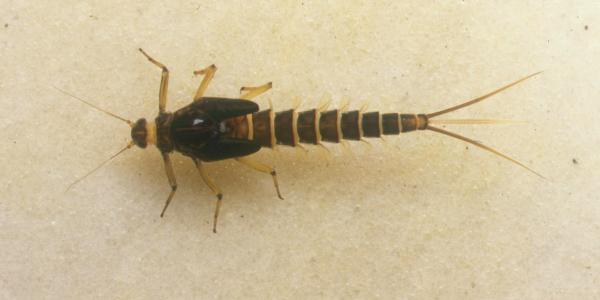
Note: strictly the genus name is Baëtis, but as people searching for information on the internet do not generally include accents (diacritical marks) such as the umlaut accent above the character ë, we have used the easier-to-type Baetis in the main text of this page.
Baetis rhodani, the Large Dark Olive, is an insect of flowing water, and it can live in steep stony streams as well as in weed-rich chalkstreams; the adults can be seen during the cold months of late autumn, winter and early spring, when few other flies are about..
Nymph
The torpedo-shaped nymphs of the Large Dark Olive and other Baetis flies are agile, and in moderate flows they are able to swim from one weedbed to another in a series of short jerky dashes. As with all members of the order Ephemeroptera found in Britain and Ireland, this insect has three tails in its nymphal stage, although like other Baetis flies it retains only two when in its winged form.
Immature Baetis rhodani nymphs have pale olive-brown translucent abdomens with darker brown thoraces and wing cases. Key identification features are the seven pairs of gills emanating from the sides of segment junctions (the leading pair and trailing pair are of similar size) and pointed spines on the straight edge of each gill. As the nymphs develop the abdomen becomes a much darker and the wing case turns almost black. This makes Frank Sawyer's famous Pheasant Tail Nymph an ideal imitative pattern for nymph fishing.
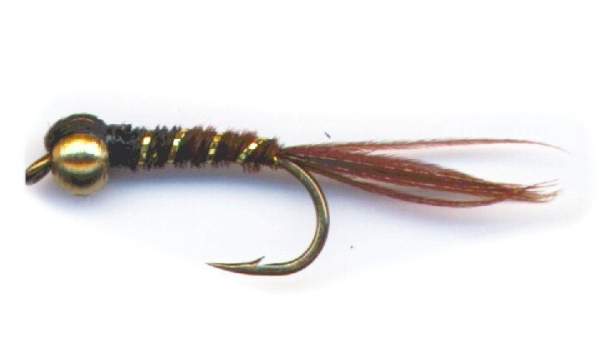
Tying tip: Most shop-bought Pheasant Tail Nymphs are too fat to be close imitations of slim, torpedo-shaped Baetis nymphs.
If you want to achieve a credible imitation of nymphs in this important group it is essential to ensure that the bodies are very slim indeed. There are two way of achieving this:
1. Tie your own nymphs and copy a pattern that is based on the form of a natural Baetis nymph.
2. Order your nymphs from a professional flydresser. They will probably cost two or three times as much as shop-bought nymphs, but at least they will work well in calmer water when the trout have plenty of time to spot major departures from the form they are used to.
There is added value in both of these options: you get good quality hooks that are less likely to snap or open out, and the durability of the artificial nymph should be very good too.
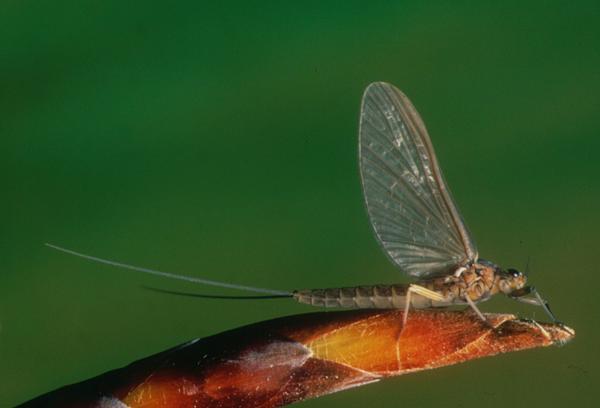
Dun or Subimago
The Large Dark Olive dun is an important insect for river fish, and particularly for trout and grayling, because it is one of the few aquatic insects available in reasonably large quantities as a source of food as these winter-breeding fish recover from the stress of spawning during the early months of the year. Insectivorous waterside birds such as the Grey Wagtail, Motacilla cinerea, also feed on the emerging duns of the Large Dark Olive.
For anglers who go flyfishing on rivers and streams during the early months of the year, this is probably the most important of all aquatic insects, because when the nymph is ready to 'hatch' into a dun it swims up to the surface; the dun then emerges in open water and takes a few moments for its wings to unfold to the point where it is able to fly. During this time the dun is potentially a meal for a trout and, of course, something that an angler can mimic with a matching artificial fly.
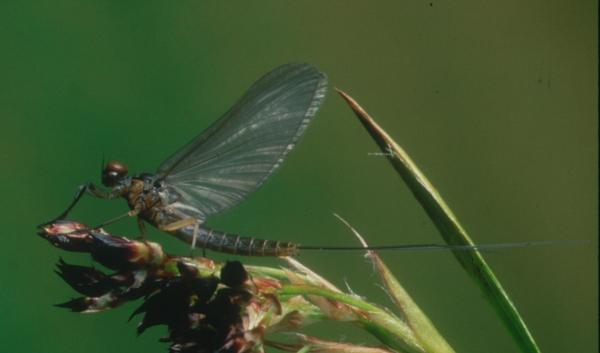
The male duns are slightly darker and have larger eyes than the females, but of course they are equally acceptable to a hungry trout. For flyfishers there really is no justification for creating separate artificial flies for imitating male and female of this species - and in fact the differences are so small that it would be almost impossible to devise credibly separate patterns for each.
Although on all but the coldest of days a few Large dark Olive duns trickle off throughout the winter months, the first significant hatches generally appear in February, with a spring peak in March and April. A few of these flies can also be seen later in the season, but other insects are more plentiful and so take on greater importance from May to September. By late autumn a second peak in the Large Dark Olive hatch usually occurs, and at that time an imitation of this handsome up-winged dun can be very useful yet again.
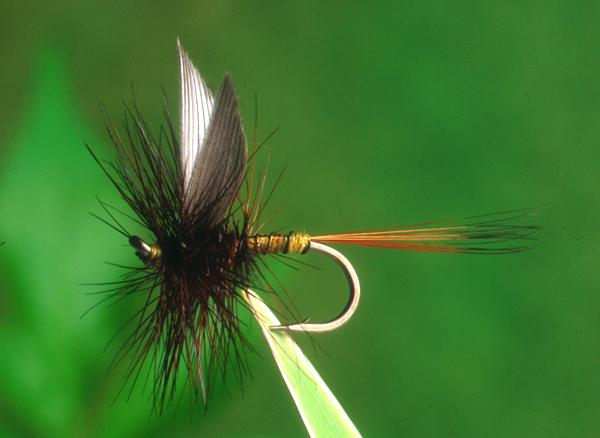
Greenwell's Glory
In early spring and late autumn, hatches of the Large Dark Olive are mainly centred around the middle of the day, with fishing at its best for two hours either side of noon. In Britain and Ireland during April and early May the hatch is more prolonged and so fishing with a Large Dark Olive dun imitation is a viable proposition from about 10am until 3 or 4pm.
Flyfishing tactics
In tumbling spate rivers and streams there is no need to use a close imitation of the Large Dark Olive dun; a general olive representation such as a Greenwell's Glory, tied on a size standard dry-fly 14 hook, is perfectly adequate.
On gently-flowing chalkstreams and on clear, slow-flowing lowland limestone rivers such as Ireland's River Boyne, a closer imitation can often make all the difference between success and failure.
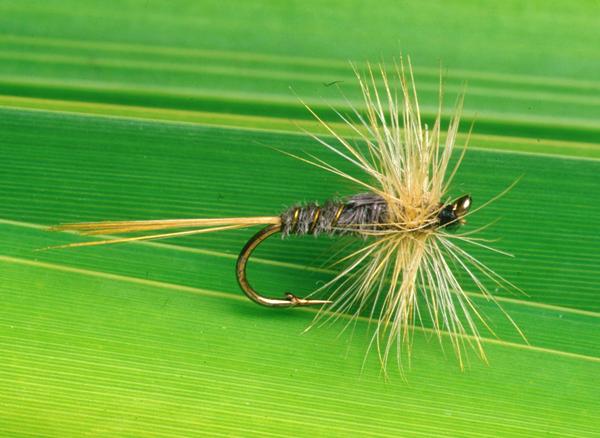
Kite's Imperial
In Matching the Hatch you will find tying details for Kite's Imperial, an excellent dry fly designed specifically for this purpose.
The Imperial was devised by Major Oliver Kite, whose television programmes in the 1960s attracted large audiences who - whether they were flyfishers of not - were captivated by his enthusiastic style. Tragically, Oliver Kite had a weak heart and suffered his first heart attack at the age of 35; in 1968 he died tragically at the age of 48, depriving us of one of angling's greatest communicators. (Oliver Kite died while fishing on one of his favourite chalkstreams, the River Test. Such a symbolic end must surely be the wish of many an angler.) Kite used to open his fishing season during the March Brown hatch on our own favourite Welsh river, the Teifi.
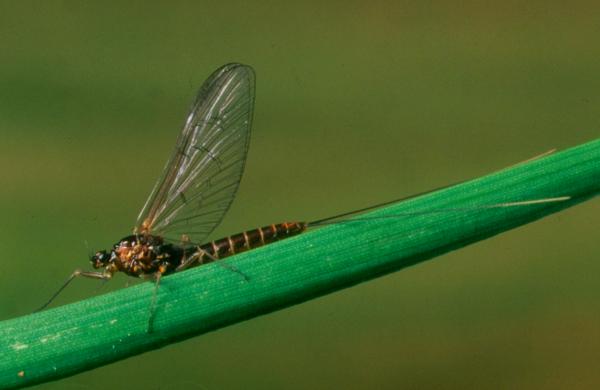
Spinner or Imago
The female Large Dark Olive spinner is reddish brown in body - hence it is sometimes referred to as the Red Spinner. The male is distinguished by its more olive body and its larger reddish eyes. Male and female spinners have transparent brown-veined wings.
The female lays her eggs on semi-submerged rocks, emergent vegetation or branches hanging beneath the surface; however, egg laying generally occurs too late in the day to provide good dry fly fishing.
Occasionally on blustery spring afternoons male Spinners of the Large Dark Olive get blown onto the water in sufficient quantities to cause a rise, and then a size 14 Pheasant Tail Spinner or simply a Kite's Imperial is all that is necessary to tempt a trout or two. For the most part, though, early season river fishers should concentrate on matching the duns when they are hatching and on nymph fishing tactics at other times.
Similar Species
Baetis atrebatinus, commonly known as the Dark Dun, is slightly smaller but otherwise very similar to the Large dark Olive; its hatching period overlaps that of Baetis rhodani and extends further into the summer. Hatches of the Dark Dun are rarely dense, and for flyfishing purposes these two up-winged flies can be treated as one and the artificial flies recommended above will work equally well as imitations of either species.
Techniques for making an artificial nymph imitate the behaviour of a Baetis nymph and tactics for dry-fly fishing during a hatch of Large Dark Olives are covered in more detail in Matching the Hatch.
Excited by rivers and streams? So are we, and we're pretty sure you would find the Winding River Mystery trilogy of action-packed thrillers gripping reading too. Dead Drift, Dead Cert, and Dead End are Pat O'Reilly's latest river-based novels, and now they are available in ebook format. Full details on our website here...
Buy each volume in ebook format for only £2.47 on Amazon... Paperbacks also available on Amazon at £6.95 each. All proceeds go towards keeping the First Nature website online.
Please Help Us: If you have found this information interesting and useful, please consider helping to keep First Nature online by making a small donation towards the web hosting and internet costs.
Any donations over and above the essential running costs will help support the conservation work of Plantlife, the Rivers Trust and charitable botanic gardens - as do author royalties and publisher proceeds from books by Pat and Sue.
